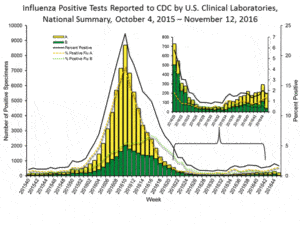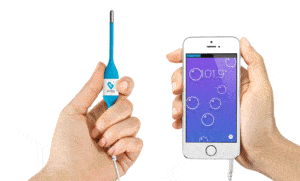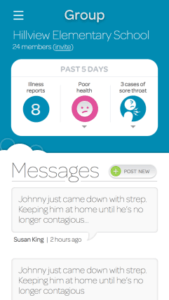Can a Smart Thermometer Stop the Spread of Contagious Illnesses?

In a world where we can instantly find the fastest route to the airport via Google Maps or get real-time Twitter updates on Trump’s presidential transition plan, we are still in the dark ages when it comes to understanding when and where diseases start and spread. Can a simple thermometer change that?
We spend billions of dollars each year trying to stop the spread of contagious illnesses. Take the recent Ebola epidemic, for example: in December 2015, the World Bank collected over $8 billion in pledges to combat the disease globally.[1] The US alone spends nearly $200 million annually trying to fight the flu.[2] But how can you effectively allocate money when you don’t know when and where these illnesses are spreading?
Kinsa is a startup solving this information gap by connecting one of the world’s most common medical devices – the thermometer – to the mobile web.
Why a smart thermometer?
The earliest sign of most contagious illnesses is a fever (just check WebMD). The first action many take to confirm they are sick is checking their temperature. With its consumer-friendly, mobile-connected thermometer and app, Kinsa leverages this behavior to collect real-time, geo-located fever and symptom information. In other words, the company can begin to understand when and where people are getting sick before they’ve even entered the healthcare system. When this data is aggregated and anonymized, Kinsa can create a real-time map of health, empowering individuals and officials to track the start and potentially stop the spread of disease. In public health, this “early detection, early response” is the holy grail.[3]
How do we currently track infectious diseases?
The current gold standard in outbreak tracking is provider-initiated reporting. Public health officials optimize for strong signals with low noise and are willing to compromise on the immediacy of results to ensure their data is certified by trusted sources such as hospitals or laboratories. Each year, the CDC publishes a weekly influenza surveillance report on its website called “FluView.”[4] These reports often lag the rate of disease spread by weeks due to the time it takes for local, state, and CDC health workers to collect and analyze the data.
Technology has already shown promise in improving our ability to predict the onset and spread of disease more quickly than provider-initiated reporting. In 2008, Google Flu Trends mined illness-related search queries to model and monitor the flu in a more timely manner.[5] Unfortunately, these efforts have suffered from low signal-to-noise ratios (SNRs) due to errors in natural language processing (NLP) and other limitations.[6],[7]

Kinsa’s business model
Kinsa is betting that its approach can address the limitations of both provider-initiated reporting and recent computational efforts. By selling the Kinsa Smart Thermometer directly to consumers, the company overcomes the time lag inherent in the current gold standard. Getting FDA 510(k) clearance for the device ensures the company is collecting medically accurate data, facilitating a higher SNR and combatting errors inherent in crowd-sourced data and NLP.
Like other Internet-of-Things companies, however, the success of Kinsa’s mission is dependent on the company’s ability to 1) drive distribution of its hardware, and 2) drive user engagement.
Understanding Kinsa’s operations

Knowing how important it was to get the thermometer in the hands of users, Kinsa designed the product to be competitive on price and user experience. To keep manufacturing costs low, Kinsa worked with suppliers in China. The company also used the headphone jack, a component costing 1/20th of what would be required for Bluetooth. [8],[9],[10] Connecting via the headphone jack allowed Kinsa to create a “magical” user experience for kids. Whereas parents used to complain that kids would fidget and hate having their temperature taken, Kinsa used the smartphone screen to gamify the experience. Once completed, parents could track symptoms and medications via the app and receive alerts as to what they to do.[11]

While the company sold the thermometer through retailers such as Apple, Target, and CVS and online at a $19.95 price point, the low bill of materials costs allowed Kinsa to experiment with other distribution models. FLUency™ was a free public school give-away program that increased usage of the thermometer, provided positive press, and served as early testing of the health map through a feature called Kinsa Groups™.[12] Groups empowered school officials and parents to see what symptoms and illnesses were going around their school, in real-time.[13]
What’s next?
Kinsa is a prime example of a company that was born out of the proliferation of mobile technology, the lowered cost of sensors, and the promise of big data. As a startup, it will face increasing strategic and operational challenges. For example, Apple removed the headphone jack in the iPhone 7. As computational technology improves, Kinsa itself risks being disrupted by software-only competitors such as Sickweather who don’t need to worry about hardware complexities. And the ultimate question remains: will the various distribution models and innovations in user experience be sufficient to penetrate enough households to collect the data needed? Only time will tell.

Word count: 778
Sources
[1] World Bank Group. “Global Ebola Response Resource Tracking,” 2015. Http://www.worldbank.org/en/topic/ebola/brief/global-ebola-response-resource-tracking
[2] Center For Disease Control. “CDC FY 2016 Congressional Justification: Overview of the Budget Request.” https://www.cdc.gov/budget/documents/fy2016/fy-2016-overview-and-detail-table.pdf
[3] World Health Organization. “Early detection, assessment and response to acute public health events,” 2014. http://www.who.int/ihr/publications/WHO_HSE_GCR_LYO_2014.4/en/
[4] Center for Disease Control. “FluView,” accessed November 17, 2016. http://www.cdc.gov/flu/weekly/
[5] Jeremy Ginsberg, Matthew H. Mohebbi, Rajan S. Patel, Lynnette Brammer, Mark S. Smolinski & Larry Brilliant, “Detecting influenza epidemics using search engine query data,” Nature, 457: 1012-1014 (19 February 2009). http://www.nature.com/nature/journal/v457/n7232/full/nature07634.html
[6] Declan Butler, “When Google Got Flu Wrong,” Nature, 13 February 2013, accessed November 17, 2016. http://www.nature.com/news/when-google-got-flu-wrong-1.12413
[7] David Lazer and Ryan Kennedy, “What We Can Learn From the Epic Failure of Google Flu Trends,” WIRED, 1 October 2015, accessed November 18, 2016. https://www.wired.com/2015/10/can-learn-epic-failure-google-flu-trends/
[8] Leah Hunter, “Why The Best Way Into Your Customer’s iPhone Is The Headphone Jack,” Fast Company, 7 May, 2014, accessed November 18, 2016. https://www.fastcompany.com/3030202/why-the-best-way-into-your-customers-iphone-is-the-headphone-jack
[9] https://www.alibaba.com/product-detail/Good-quality-3-5mm-trrs-plug_2022458492.html
[10] https://www.alibaba.com/product-detail/BLE-4-0-nordic-chip-nRF51822_60337045055.html
[11] Lauren Kay, “Kinsa Smart Stick Thermometer Review: See why this digital thermometer might deserve a place in your medicine cabinet,” accessed November 18, 2016. http://www.thebump.com/a/kinsa-smart-stick-thermometer-review
[12] Kinsa. https://www.kinsahealth.com/fluency
[13] Zina Moukheiber, “On A Mission To Detect The Flu And Other Infectious Diseases With A Thermometer,” Forbes, 11 December 2014, accessed November 18, 2016. http://www.forbes.com/sites/zinamoukheiber/2014/12/11/on-a-mission-to-track-the-flu-and-other-infectious-diseases-with-a-thermometer/#1ad2cee92603



QQ – Great article. I can definitely see the value in this medical device, but as you stated in your article, my big concern is customer distribution and engagement. What is the incentive for someone to purchase a $20 thermometer when they can use a free website or app that can tell them when and when not to see the doctor? I assume easy-of-use and FDA compliance makes this an attractive technology when considering to buy or not, but is this enough to overcome this barrier to market entry?
Another thing I am concerned about is that high consumer distribution and engagement of this technology is required to generate the large data sets in order to identify hot zones. It is for this reason that health privacy concerns could be a deterrent to consumer use. Also, how accurate will the data be if people are self-diagnosing their symptoms that are not confirmed by a doctor? How do we really know if they have a flu or have acquired some other virus? I definitely see the value in this technology, but there are some considerations that Kinesa is hopefully working through.
Hey Tarran, great questions. A common challenge for IoT companies is to effectively create and then subsequently communicate the added benefit of a connected device versus its non-connected analog. From Kinsa’s perspective, there are several benefits such as the user experience around the bubble game for kids, ability to join private groups and see what’s going around their local area, etc. However, it’s surprisingly difficult to communicate this value proposition on a retail shelf – relying on messaging on the package is just insufficient. So interestingly, as IoT products have become more popular, we’re seeing more and more retailers changing how they sell these products. Target, for example, created Target Open House (http://openhouse.target.com/app/#/) to enable users to interact with the products so they can actually experience the value before buying it.
On the accuracy of data – I believe Kinsa is banking on the fact that having medically-validated fever data will help level-set the self-reported symptomatic and diagnosed illness information. But you’re absolutely right that there are still challenges for them to overcome as they try to move from fever towards actually identifying specific illnesses & I’m just as intrigued as you are to see how they tackle this.
Qian Qian – What a well-written post on a fascinating start-up. As you rightly point out, achieving the “early detection, early response” holy grail will require getting Kinsa in the hands of as many users as possible. At the risk of suggesting something very paternalistic, I’m wondering whether one solution to Kinsa’s economic success (and to more effective public health responses to infectious disease) is for Kinsa to partner with government so that distribution of the devices can occur primarily via the public sector? I imagine this would be fairly difficult to achieve in the U.S. given the fragmented nature of the healthcare system – and presumably especially controversial in the political context in the next several years – but perhaps a country with a socialized system (e.g., NHS in the UK) would be a better place to experiment. If the government were to subsidize the cost of a Kinsa for every household, or provide it for free for households below a certain income level, this would solve your first criterion for Kinsa’s success (driving uptake). I’d be curious to hear your thoughts/ concerns about this.
Hey Brittany- great suggestion! I think you’re absolutely right in that Kinsa should partner with governments to distribute the device and hopefully it’s something they are considering for the future. My understanding is that they are sticking to the US-only right now to iterate on the best user experience to ensure continuous engagement with the thermometer and the app. Unfortunately, simply distributing the thermometer is useless if people don’t use it. One of the most commonly discussed topics in giving away product is around how to create “perceived value,” and Kinsa will need to think through this as it diversifies its distribution.
Awesome post. I’d be very interested in hearing more about Kinsa’s efforts behind ensuring clean data and whether they ultimately see themselves as a data provider more so than a hardware distributor. To your point, public health officials are optimizing for accuracy at the sacrifice of timeliness. I understand Kinsa has the potential to gather much larger data sets and more quickly, but I imagine there are inherently challenges identifying what is a signal for a potential flu outbreak vs. noise in the data from misuse of the thermometer as both will likely present themselves as outliers. Ultimately, this is also a question of whether Kinsa plans to take on the burden of analyzing that data or form partnerships with public health organizations and simply provide its data for analyses.
Really interesting post! For me, Kinsa raises a big question about privacy. The data is theoretically anonymized, but I wonder how well Kinsa protects the data of its users and what kinds of privacy risks users are exposed to. As we willingly offer up more and more information about ourselves, including our very own biological condition, I begin to suspect that we are making less and less informed decisions about privacy and where our data goes. Are we comfortable in a world where Kinsa is the safeguard between the world and our personal medical history? How do we protect ourselves as consumers from giving away too much information? Essentially, do we have a right to digital privacy, and, if so, how do we ensure it while simultaneously benefiting from tools like Kinsa?
I had never heard of Kinsa, so really enjoyed reading this post. I like the idea of using hardware to lend some scientific validity to the diagnosis process; searching our own symptoms on Web MD without inputting any data as always been an incomplete and imprecise approach. I also like that Kinsa is reasonably priced so that plenty of people can access the technology – the more data in Kinsa’s network, the better!
The only thing I’m struggling with is temperature as the key input. This seems like one of many critical health indicators that should go into a diagnosis. If the rest of the diagnosis depends on self-reported symptoms, then it is only a few degrees of precision past Web MD. That said, the ability to map the spread of disease in an area seems unique and proprietary, and I’m excited to see where that technology could go.
Great post! Awesome to see a start-up focused on using advancements in technology to tackle health related issues. As some of the prior posts have mentioned, I agree that it is key for Kinsa to scale quickly. I imagine this is a highly competitive space. What barriers to entry (if any) does Kinsa have? It seems like the device is relatively inexpensive to manufacture and that thermometer technology has been around for a long time. Wouldn’t it be easy for an established player to release a similar product and take market share? Also are people comfortable with sharing their information, despite it being anonymous – the alternative being a regular thermometer? I am also curious to see what the “user threshold” is in order to start seeing benefits from the data / analytics. Very cool post!
Thank you for sharing. While i do think that this product is very smart and relevant, i’m hesitant about how the data will be used and perceived by customers. As a parent I think it’s great to be able to look up who else in the area may also have a fever, and if there happens to be a local outbreak, but do i want information about my child’s health to be out there for others to see? Moving forward i think one of the challenges is overcoming potential privacy issues.
I love the article! I think the product has a lot of potential. Google right now is able to do a similar track of sicknesses based on people searches. How do you see this product compete against them?
I think there is great potential for this application particularly in large-scale quarantine as in the case of the major ebola outbreak last year in Africa. Having this kind of tool is potentially a game-changer for researchers (e.g. CDC). I would also think that a natural extension is to be able to focus resources in real-time as a n outbreak develops. Fantastic post!